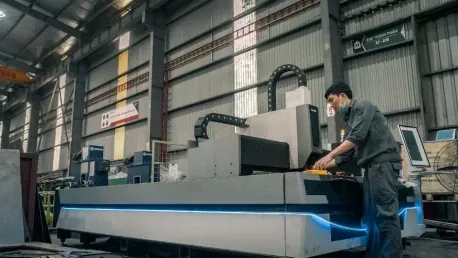The landscape of warehouse automation is undergoing a significant transformation, driven by advancements in artificial intelligence (AI) and robotics. At the forefront of this revolution is Symbotic, a company that has harnessed the power of AI to streamline and enhance warehouse operations. This article explores Symbotic’s innovative technologies, market potential, strategic partnerships, financial performance, and the broader implications for the industry.
Symbotic’s Technological Innovations
AI-Driven Robotics
Symbotic has developed cutting-edge robotic platforms that leverage AI to automate various warehouse tasks. These autonomous robots are capable of sorting, storing, and retrieving goods with minimal human intervention. The integration of machine learning algorithms allows these robots to continuously improve their efficiency, reducing errors and boosting productivity over time. This technology mirrors the operational strengths seen in major retail giants like Amazon, setting a new standard in the industry. By utilizing advanced sensors and AI, Symbotic’s robotic systems can navigate complex warehouse environments, identifying the optimal paths for picking and placing goods. This not only minimizes operational costs but also enhances overall accuracy in inventory management.
The ability of Symbotic’s robots to adapt and learn from their environment sets them apart from conventional automation systems. Over time, these AI-driven robots gather and analyze data, refining their processes to better meet the demands of the warehouse. This dynamic optimization ensures that the systems remain efficient even as the complexity of tasks increases. In addition, Symbotic’s solutions are designed to be seamlessly integrated into existing warehouse infrastructure, allowing companies to upgrade their operations without significant overhauls. The end result is a more efficient, reliable, and scalable warehouse operation capable of meeting the increasing demands of the modern retail environment.
Adaptive Systems
One of the standout features of Symbotic’s technology is its adaptability. The AI-driven systems are designed to learn and optimize their functions, making them suitable for a wide range of warehouse sizes and complexities. This scalability ensures that Symbotic’s solutions can be tailored to meet the specific needs of different clients, providing a versatile and efficient approach to warehouse automation. The company’s adaptive systems are capable of managing diverse product types, from bulk items to fragile goods, without compromising efficiency or accuracy. This adaptability is crucial as it allows warehouses to handle fluctuating inventory and seasonal changes seamlessly.
Moreover, Symbotic’s adaptive systems can be programmed to handle specific customer requirements, such as customized packaging or specialized handling instructions. This level of customization is essential for businesses looking to maintain high levels of customer satisfaction. Furthermore, by continuously learning from operational data, Symbotic’s systems can anticipate and respond to potential issues before they escalate, ensuring smooth and uninterrupted operations. This proactive approach to warehouse management not only enhances productivity but also significantly reduces downtime and operational costs, giving Symbotic a competitive edge in the market.
Market Potential and Growth Trends
Expanding Market
The warehouse automation market is experiencing rapid growth, driven by the increasing demand for efficient inventory management and streamlined distribution channels. Valued at over $23 billion in 2023, the market is projected to reach approximately $41 billion by 2027. This growth is fueled by the rise of e-commerce and the need for retailers to meet evolving consumer expectations. Symbotic is well-positioned to capitalize on these trends, offering solutions that enhance operational efficiency and reduce costs. The growth of online shopping has created an urgent need for faster and more accurate order fulfillment, which in turn drives the demand for advanced warehouse automation solutions.
Additionally, the COVID-19 pandemic has accelerated the adoption of automation as businesses seek to minimize human contact and improve operational resilience. Symbotic’s AI-driven systems are particularly suited to this new normal, providing a touchless solution that can operate efficiently in a socially-distanced ecosystem. The operational benefits offered by Symbotic’s technology, including reduced labor costs, increased throughput, and enhanced accuracy, make it an attractive investment for companies looking to future-proof their supply chain operations. As a result, the company is likely to see substantial growth in the coming years as it continues to meet the evolving needs of the market.
Strategic Position
Symbotic’s strategic position in the market is bolstered by its robust technology and innovative approach. The company’s AI-driven systems provide a significant competitive edge, enabling clients to achieve higher levels of efficiency and accuracy in their warehouse operations. As demand for automation continues to rise, Symbotic’s technology is poised to play a crucial role in shaping the future of the industry. The company’s focus on innovation and continuous improvement ensures that it remains at the cutting edge of warehouse automation technology. By addressing the key pain points in traditional warehouse operations, Symbotic offers solutions that are both practical and forward-thinking.
Furthermore, Symbotic’s emphasis on scalability means that its systems can grow with clients’ needs, accommodating increases in volume and complexity over time. This makes it a preferred partner for businesses looking to implement long-term automation strategies. In addition, the company’s commitment to customer success through extensive support and maintenance services provides clients with the confidence that they have a reliable partner in their automation journey. With such a strong value proposition, Symbotic is well-positioned to expand its market share and solidify its position as a leader in AI-driven warehouse automation.
Financial Performance and Market Risks
Revenue Growth and Challenges
Symbotic has demonstrated impressive revenue growth, with a 52% increase to $1.8 billion in fiscal 2024. However, the company has also faced financial challenges, including a 45% drop in stock price and a reported net loss. Despite these setbacks, Symbotic achieved profitability in the last quarter, indicating a potential turnaround. This financial volatility highlights the risks associated with investing in emerging technologies, but also underscores the potential for significant returns. The company’s financial performance is a reflection of the high stakes and fast-paced nature of the tech industry, where rapid innovation can lead to substantial rewards or setbacks.
Investors must consider these dynamics when evaluating Symbotic’s long-term prospects. The path to profitability may be fraught with challenges, including competition, technological disruptions, and market fluctuations. However, the company’s strong fundamentals and clear growth trajectory offer reasons for optimism. Symbotic’s ability to achieve profitability, even in a turbulent fiscal year, demonstrates its resilience and potential for sustained financial success. For investors willing to embrace the inherent risks, Symbotic presents an opportunity to be part of a transformative journey in the warehouse automation sector.
Dependency on Key Partnerships
A notable risk for Symbotic is its heavy reliance on Walmart, which accounts for a large share of its revenue. While the long-term contract with Walmart, extending until 2034, showcases confidence in Symbotic’s technology, it also presents a dependency risk. Any issues in this partnership could have significant implications for Symbotic’s financial stability. Investors must consider this dependency when evaluating the company’s long-term prospects. Diversifying its client base could mitigate such risks, making strategic partnerships and expansion into new markets critical for Symbotic’s sustained growth.
The company has already taken steps in this direction, exploring collaborations with other major retailers and expanding its technological offerings. Additionally, Symbotic’s ongoing efforts to innovate and improve its products could attract a broader range of clients, reducing its dependency on a single partnership. However, the company must carefully manage its relationships to avoid over-reliance on any single source of revenue. Balancing the benefits of strong partnerships with the need for diversification will be key to Symbotic’s long-term success and financial stability.
Strategic Partnerships and Future Outlook
Walmart Partnership
Symbotic’s partnership with Walmart is a cornerstone of its business strategy. The long-term contract not only provides financial stability but also validates the effectiveness of Symbotic’s technology. This collaboration has enabled Symbotic to refine its systems and expand its market presence, positioning the company for future growth. Walmart’s endorsement of Symbotic’s solutions serves as a powerful testament to their practicality and efficiency, enhancing the company’s credibility in the marketplace. The success of this partnership has also opened doors for Symbotic to pursue similar opportunities with other major retailers.
By leveraging the experience gained from its collaboration with Walmart, Symbotic can apply its proven solutions to a wider array of clients, further accelerating its growth. This strategic positioning allows the company to scale its operations effectively, adapting its systems to meet the needs of diverse industries. In turn, this broadens Symbotic’s market reach, solidifying its reputation as a leader in AI-driven warehouse automation. The Walmart partnership also highlights Symbotic’s ability to manage large-scale implementations, providing a blueprint for future collaborations and market expansion.
Global Expansion with SoftBank
In addition to its partnership with Walmart, Symbotic has teamed up with SoftBank on the GreenBox initiative. This collaboration aims to expand Symbotic’s reach beyond North America, targeting global markets with its innovative warehouse automation solutions. The GreenBox initiative represents a significant opportunity for Symbotic to broaden its client base and capitalize on the growing demand for AI-driven automation worldwide. SoftBank’s extensive network and resources provide Symbotic with the necessary support to navigate international markets and address diverse logistical challenges.
The global expansion efforts signal Symbotic’s strategic intent to establish a presence in regions with high growth potential. This initiative not only diversifies the company’s revenue streams but also mitigates risks associated with dependency on a single market. By entering new territories, Symbotic can leverage varying market dynamics and capture emerging opportunities. Moreover, the collaboration with SoftBank underscores Symbotic’s commitment to innovation and growth, ensuring that it remains at the forefront of industry advancements. As Symbotic continues to execute its expansion strategy, it is well-positioned to become a global leader in warehouse automation, driving efficiency and productivity across supply chains worldwide.
Broader Implications for the Industry
AI-Driven Automation as a Game Changer
The integration of AI in supply chain operations is revolutionizing the warehouse automation industry. Symbotic’s continuous advancements in robotics and machine learning set a benchmark for efficiency and accuracy. As more companies adopt AI-driven solutions, the industry is poised for significant transformation, with Symbotic leading the charge. The adoption of such technologies promises not only to streamline operations but also to reduce costs and improve overall efficiency in warehouse management. Innovations like these significantly impact the industry’s landscape, setting new standards for what is achievable in terms of speed, accuracy, and adaptability.
The advances in AI and robotics have far-reaching implications beyond just operational efficiencies. They offer solutions to critical challenges like labor shortages, rising operational costs, and the growing complexity of inventory management. Symbotic’s technology, with its ability to learn and adapt, addresses these issues head-on, offering a robust alternative to traditional manual methods. As companies continue to explore AI-driven automation, they pave the way for further innovation, fostering an environment where continuous improvement and technological advancement are the norms. This shift underscores the pivotal role of AI in shaping the future of warehouse and supply chain operations.
Future Prospects and Challenges
The landscape of warehouse automation is experiencing a considerable shift, largely propelled by advancements in artificial intelligence (AI) and robotics technologies. Leading this transformation is Symbotic, a company that has adeptly utilized AI to optimize and fortify warehouse operations. This piece delves into Symbotic’s groundbreaking technologies, assessing its market potential, strategic alliances, and financial achievements. It also examines the larger ramifications for the industry as a whole.
Warehouse automation has always strived to improve efficiency and accuracy, but the integration of AI and robotics marks a new era. Symbotic’s innovative solutions are setting new standards by leveraging AI to handle complex tasks, thus reducing human error, cutting costs, and increasing speed. Their strong market position is supported by strategic partnerships with major retailers and logistics companies, facilitating smoother supply chain operations. Financially, Symbotic’s performance reflects its success, showcasing robust growth and a promising future. The broader implications for the industry suggest a trend towards ever-increasing automation and reliance on advanced technologies.









